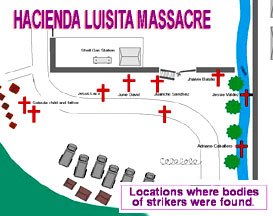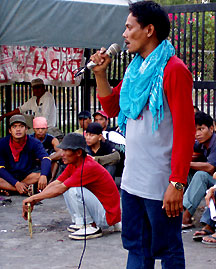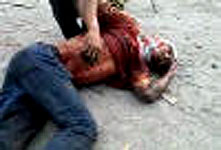|
The Tarlac Massacre:
How It Happened
The violence that
marred the strike of plantation and milling workers of the Cojuangco-owned
Hacienda Luisita on Nov. 16 was bound to happen and government authorities
may have to account for it.
BY RONALYN OLEA AND
DABET CASTAÑEDA
Bulatlat

Click on drawing for illustrated sequence of events
HACIENDA LUISITA, Tarlac City – The
violence that marred the strike of plantation and milling workers of the
Cojuangco-owned Hacienda Luisita on Nov. 16 was bound to happen and
government authorities may have to be held accountable for it.
This appears to be the finding based
on accounts, testimonies and results of fact-finding missions gathered by Bulatlat.
The same reports pointed to the fact that military and police forces,
acting on orders of the labor department, appeared intent on breaking up
the picket of the striking workers days before the Nov. 16 dispersal that
claimed the lives of seven strikers and the wounding of at least 200
others. (Other reports said 14 were killed.)
 
Fellow strikers bid massacre victims goodbye
in a 6,000-strong funeral march, with vows to fight for justice
Photos by Ronalyn Olea (left) and Dabet
Castañeda (right)
About 5,000 sugar farm workers and 500
sugar mill workers went on strike on Nov. 6 (Saturday) to demand, among others,
the reinstatement of 327 workers led by union leaders earlier laid off by
the Hacienda Luisita, Inc. (HLI) management. Two unions led the strike:
the United Luisita Workers Union (ULWU, union of the plantation workers)
and the Central Azucarera de Tarlac Labor Union (Catlu) of the milling
workers. ULWU strikers manned Gate 1 – the entrance leading to the
Central Azucarera de Tarlac (CAT) - located
south of the hacienda, which is a one-hour walk from the MacArthur
national highway while those from Catlu took their position outside Gate 2
north of the 6,000-ha plantation. Human barricades had formed outside Gate
1 to block trucks loaded with sugarcane from entering the sugar mill
inside the hacienda.
The hacienda, which is owned by the
family of former President Corazon Cojuangco-Aquino, is about 100 kms
north of Manila.
Church bells
For four days beginning Nov. 13,
responding to the tolling of church bells, thousands of residents and
sympathizers of the striking workers came in droves every time police
authorities came and threatened to disperse the picket line of the sugar
farm workers. Thousands of
other residents from 10 villages comprising the hacienda, ULWU leaders
said in a statement on Nov. 13, would mass up at night at Gate 1 in
anticipation of a violent dispersal.
Threats of dispersal placed the
workers in high alert after Secretary Patricia Sto. Tomas of the
Department of Labor and Employment (DoLE) issued on Nov. 10 an Assumption
of Jurisdiction (AJ). Sto. Tomas ordered the striking workers to return to
work so the company could resume its operations in 24 hours. Apparently,
the labor secretary’s order also directed the Philippine National Police
(PNP) and the Armed Forces of the Philippines (AFP) to dismantle the
barricades put up by the strikers and break up the strike.
|
That the dispersal order was to be
executed by all means was not remote, ULWU president Rene Galang said in
an interview with Bulatlat during the early stage of the strike.
Since Day 1 of the strike the workers were already being driven out of
their picket lines.
At around 6 p.m. on Nov. 6, policemen
used tear gas and water cannons to drive the strikers out of the CAT gate.
Another dispersal took place at the crack of dawn the following day where
at least 80 people including children and the elderly were hurt.
|
 |
Farm workers interviewed by Bulatlat
said tension rose on Nov. 15 as the 6,000 strikers were reinforced by
9,000 residents from the hacienda’s 10 barangays (villages) at Gate 1.
They stood their ground as about 300 policemen came and in formation tried
to break the strikers’ ranks.
To ease the tension, about 10
policewomen deployed themselves at the police front line. This prompted
about 50 women strikers to also take the frontline to face the
policewomen. At the right side of the ground, male strikers stood across
the male policemen.
The police were armed with truncheons
and shields while the hacienda workers had their own truncheons made of
pieces of wood, said Rene Tua, a sugar mill worker and adviser of the CAT
labor union (or Catlu).
 |
Negotiation
Sensing they were outnumbered, the
police were forced to negotiate with the strike leaders, Tua said.
Tulakan lang (just pushing and shoving).
No coming into blows, tear gas or water cannon.
The streamer says it
all: "Enough! We are hungry!"
Photo by Dabet
Castañeda
|
At the count of three, Tua said, the
combined forces of the plantation and sugar mill workers pushed the entire
police contingent. Seemingly winning the battle at this point, Tua said,
the workers became jubilant, others even laughing and jumping until the
police, humiliated by their setback, started hitting the strikers with
their truncheons.
In the scuffle, the workers
confiscated five police shields. But they returned the shields after the
police said they will be paying for them if they got lost, Tua said.
A number of strikers were hurt, among
them Catlu president Ricardo Ramos who was hit on the head.
But Tua said the strikers held their
ground until the police were forced to leave before sunset.
Upon the intervention of Bayan Muna
Rep. Satur Ocampo, three Catlu leaders (including Tua) and two others from
ULWU traveled to Makati City in Metro Manila the following for a 10 a.m.
meeting with Jose Cojuangco, Jr. in his mansion.
In a press conference last Nov. 18,
Ocampo related how Cojuangco – brother of former President Aquino -
reacted to his request for dialogue.
“Kung ayaw ko nang papasukin sa bahay ko, bakit magpupumilit
pa?” (If I do not want to accept someone in my home, why would he
insist?). Ocampo replied, “Baka may karapatan din sila” (Maybe,
he also has a right).
Tua said, “Ayaw kaming kausapin. Gusto si Ka Satur lang. Lumabas na kami.” (They did not want
to talk to us. They only
wanted Ka Satur. So we walked out.)
Tua said further, “Sabi niya (Peping),
may AJ na ang DoLE” (Peping said the DoLE had issued an AJ). It was
at this point, he said, that he feared something big was going to happen.
He, along with the other union leaders, went back to Tarlac in haste.
True enough, while the Makati meeting
was ongoing about 300 Army soldiers aboard 19 military trucks slipped
through the east gate of the hacienda.
Final dispersal try
Emil Paragas, Karapatan Tarlac
coordinator, was at the picket line outside Gate 1 to observe the strike.
He related the full account of the Nov. 16 massacre.
Another major dispersal was at work,
Paragas recalled, this time with the police reinforced by soldiers from
the Northern Luzon Command (Nolcom) based at Camp Aquino which is just
across the highway overlooking the hacienda. Policemen were at the
frontline of the dispersal formation, he said. Behind them were agents of
Nolcom. Three fire trucks and
an armored personnel carrier (APC) were positioned inside Gate 1.
At 3:10 p.m., the police began using
water cannons to drive away the protesters. A few minutes later, tear gas
filled the air. Paragas said there were more than 200 canisters of tear
gas thrown at the workers.
But the strikers were ready, Flor
Sibayan, who was among them, recalled. They brought pails of water from
nearby Balite village and used these to catch the tear gas canisters.
Those that hit the ground were immediately covered with wet cloths and
were spilled with water. “Para
lang kaming nanghuhuli ng daga” (It was like we were catching mice),
is how Sibayan described the incident.
The workers, Paragas said, were
determined to maintain the picket line. “Bumabalik ang mga manggagawa
kapag humuhupa na ang epekto ng tear gas” (Workers would return to
the picket line every time the effect of the tear gas weakens).
Then, Paragas continued, thrice the
APC rammed into the gate. Paragas said he heard workers shout, “Nagkasahan
na” (Rifles were cocked).

One of the missing victims
Photo courtesy of Tudla
Then, the shooting began. Paragas said
he saw soldiers armed with long rifles position themselves on the open
field at the right side of the sugar mill and at the left side of the
gate. Gunshots also came from the gate, he said. There is a high
probability, he said, that other soldiers positioned at the left side of
the sugar mill used silencers.
Jun David, one of those killed, was
hit from the left side of the CAT, he said. “Katabi ko siya nang
tamaan siya ng bala. Wala
siyang armas.” (He was beside me when he was hit. He was unarmed.)
Soldiers gave chase as striking workers ran for safety toward the nearest
barangay.
All told, the volley of gunfire lasted
for two minutes, Paragas said. The Karapatan fact-finding mission later
found spent shells of M-14 and M-16 rifles. Karapatan also said the
soldiers used a 60-cal. machine gun.
The shooting killed seven union
members and residents of Hacienda Luisita. They were David, Jhaivie Basilio, Jesus Laza, Jessie Valdez,
Juancho Sanchez, Adriano Caballero Jr. and Jaime Pastidio.
Unaccounted for
Six more were reportedly killed but
their bodies have yet to be found. Union officers said they could not
identify them because they were sacadas (seasonal plantation
workers) who came from different provinces of Visayas and Luzon.
Tudla, an independent audio-visual
group, captured a video of a man who was shot in the back.
This man has not been accounted for as of press time.
One witness, a woman sugar farm worker
from Lourdes village, also related the incident to Bulatlat. “Nagtatago
ako sa kanal. Nakita ko yung
mama pumulot ng bato. Binaril
siya. May mga nagsakay sa
kanya sa tricycle. Hindi na namin alam nasaan na siya”
(I was hiding in a canal. I
saw a man picking up a stone. He was shot. We do not know where he was
taken.), she said.
|
Some of those who died could have
lived had they been allowed to be brought directly to the Tarlac
provincial hospital. But soldiers and policemen ordered them at gunpoint
to take a longer route – a 12-km ride from Gate 1 to the hospital’s
emergency room.
Sibayan said one of the fatalities,
Juancho Sanchez, was still alive when he was brought to the hospital.
But he lost a lot of blood. Sanchez’s feet were run over by the
APC. Unable to rise, he lost consciousness when a soldier hit him on the
face. Sibayan, who herself was hit in the left shoulder, said she could
still hear Sanchez breathing while lying beside her in the hospital bed.
Sanchez succumbed to his wounds that night.
|

Witness points to where she was hiding
when she witnessed how one of the victims was hit
Photo by Dabet Castañeda |
About 72 wounded strikers soaked in
their own blood as they were hurled into the Emergency Room; 34 of them
sustained gunshot wounds.
In a press conference held two days
later in Quezon City, Catlu lawyer Noel Neri said that the military
prevented families of victims from immediately recovering their dead.
Aside from the dead and wounded, 111
others, including 16 women and two minors, were arrested and charged with
physical assault, resisting persons in authority and malicious mischief.
Neri said most of those arrested were actually sacadas from Negros,
Batangas and other provinces who were picked up by the military from their
bunkhouse.
Accounts also told of soldiers mowing
down the father of a baby who died of asphyxiation resulting from the tear
gas attack; of Basilio who was reportedly strangled and hanged in the
barbed wire at Gate 1 before he was shot dead.
Testimonies by scores of many
eyewitnesses and the victims themselves, video shots and still photos
indicate that the protesters were unarmed and that some gunshots came from
snipers positioned in the open field to the right facing the sugar mill
and on top of the reservoir farther back, and from the soldiers near the
entrance of Gate 1.
Anakpawis Rep. Rafael Mariano, who was
one of those who went to investigate the massacre on Nov. 17, said he and
his group were on their way to the hacienda when 11 truckloads of soldiers
rumbled out of the area toward Camp Aquino.
Mariano said he even talked to Col.
Romeo Reyes of Nolcom. In their brief talk, Reyes admitted to Mariano that
he and his men arrived at the picket line at 2 p.m. of Nov. 16.
The colonel also said there were 271 of them along with two APCs.
Mariano would say later, “Sila ay
naroon nang maganap ang pamamaslang”(They [military] were there when
the killings occurred).
“Deliberate and premeditated”
In a Nov. 23 statement, Galang accused
the Cojuangcos and the military and police dispersal teams of a
“deliberate and premeditated intent…to kill sugar mill and farm
workers on strike.” He also said the killings were committed with the
“full consent and awareness of the Arroyo administration and DoLE.”
Meanwhile, Executive Secretary Eduardo
Ermita, a retired four-star general who occupied key government positions
during the presidency of Aquino, said the New People's Army was involved
in the Nov. 16 killings.
During a meeting at the Cojuangco
residence attended by city and barangay officials Nov. 18, Rep. Benigno
Aquino III's commented that NPA rebels may have possibly infiltrated the
strikers.
In another statement released to the
media, the Cojuangco family alleged that “outside forces are influencing
the situation, resorting to intimidation of non-striking workers and even
to the destruction of millions of pesos worth of crops.”
However, Barangay chairman Rodel
Galang of Barangay Balete, Tarlac City countered that he knows all the
people who converged at Gate 1 on Nov. 16. All were unarmed, he said,
adding that there are no NPA men in his barangay or elsewhere in the
picket site at the time of the shooting.
In a statement sent through email,
Gregorio "Ka Roger" Rosal, spokesperson of the Communist Party
of the Philippines (CPP), said that the NPA had no participation in the
Nov. 16 Hacienda Luisita demonstration.
Rosal added that the NPA had no hand
in the mobilization of thousands of peasants supporting the workers'
strike at CAT. “The NPA is
careful not to step within the bounds of the people's legal struggle
precisely to prevent reactionaries from using this to justify the use of
armed means to quell the people's legitimate unarmed struggles,” he
said.
On the contrary, striking workers
reported seeing suspected military infiltrators in their ranks.
During the shooting, Tua said, a plainclothesman was pointing at
him and the other union leaders, apparently as to be shot or arrested.
During the funeral march of the massacre victims on Nov. 21,
mourners caught a suspected agent of Nolcom taking pictures.
“Nahuli namin kasi hindi siya marunong gumamit ng kamera. Nang tanungin siya, pang-souvenir lang daw” (We caught
him because he doesn’t know how to use the camera.
When our colleagues asked him, he said it’s just for souvenir),
he said.
Struggle continues
The night after the massacre, Tua said
about 80 of the plantation and sugar workers returned to the picket line.
“Naisip namin baka dukutin na lang kami” (We were thinking we
could just be abducted). The following morning, the number of people at
the picket line swelled with the return of other union members and their
families.
The Nov. 21 funeral march was attended
by more than 6,000 people. At
the head of the march-rally was a streamer that read “Tuloy ang laban!
Tuloy ang welga!” (The
struggle continues. The
strike goes on.) Bulatlat
BACK TO TOP ■
PRINTER-FRIENDLY VERSION ■
COMMENT
© 2004 Bulatlat
■ Alipato Publications Permission is granted to reprint or redistribute this article, provided its author/s and Bulatlat are properly credited and notified. |